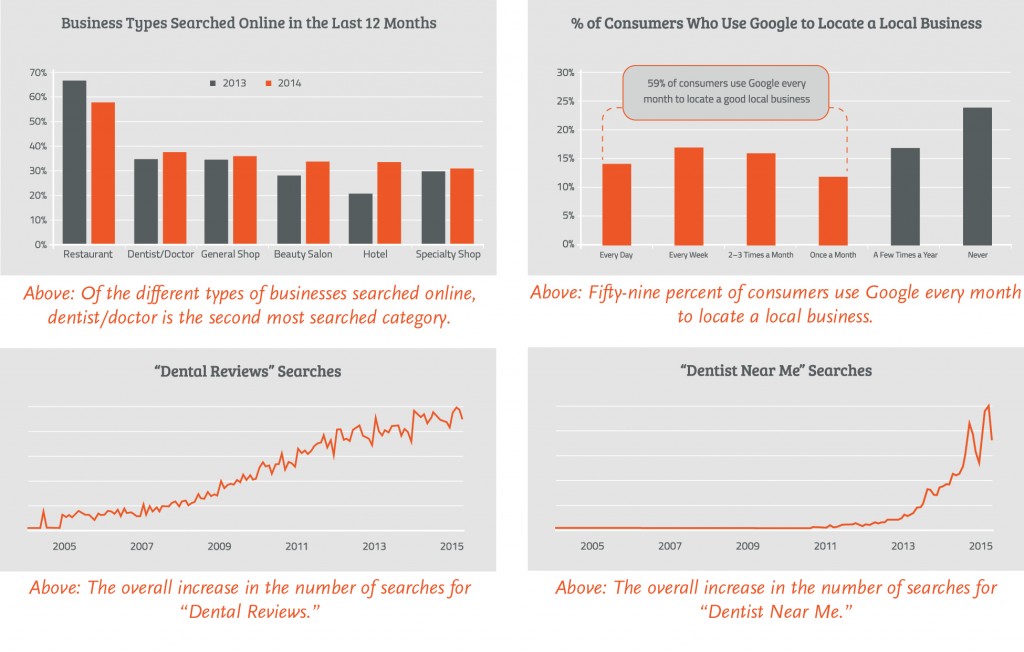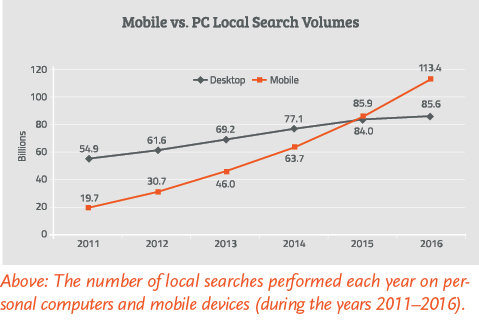
THE DANGERS OF NEGLECTING YOUR WEBSITE.
This article is the first installment of a multi-part series on the topic of online marketing. Look for additional articles designed to help with your online marketing efforts in future issues.
Approximately 80 percent of all people will research information about a product or service before purchasing it. And all of those consumers use the Internet as the primary way to conduct research. A challenge for every dentist is ensuring that your information is found easily and more importantly, that it is found first.
 An Online Presence
An Online Presence
What does that mean for the modern dental practice? Quite simply, if you don’t have an online presence with an effective website, your ability to compete is in danger. Dentists should view a website as an online extension of their practice. More specifically, it is the online version of the front office of your practice. The website should engage with new and existing patients on their time frame. And just like a new patient can visit a physical office and ask questions of the front office staff, a person can also visit an online office and gather similar information. Some of the most important benefits of a webpage are: it offers patients a sense of anonymity (which allows them to more fully investigate you and your practice on their terms), it allows patients to get a better idea of what makes your practice different from the others, and it communicates that you are up-to-date and relevant.
The key elements of a standard website include: information about the dentists, dental team and their backgrounds; information about the types of treatments that are offered; pictures and videos of treatment outcomes; patient testimonials and any other key messages that you feel are important for your patients. Visitors can spend an unlimited amount of time browsing these important features and getting to know what makes your practice unique.
Make sure that your website differentiates your practice from the competition. If your site doesn’t set your practice apart, visitors will likely make choices based on convenience factors, such as price or appointment availability. Your website should clearly show why your practice outshines others and why patients should trust you with their oral health.
No other marketing tool compares to a well-executed website. Leads generated from social media platforms will eventually land on your website and what a patient finds largely determines if they will contact you.
I’m Set—I’m on Facebook
An online presence has many different layers. The social media aspect of an online presence includes Google+, LinkedIn, and Facebook, among several others. These powerful tools allow patients to interact with you and others who have direct experience with you in a way that is comfortable and easy to access.
But some businesses mistakenly assume that presence on a social media platform is a substitute for a traditional web page. Nothing could be further from the truth. Because social media platforms generally require a user to have an account, by solely relying on a social media platform, you limit the reach of your online presence to the individuals on that platform.
Also, with social media, your profile is subject to a predetermined layout that makes you look like pretty much every other dentist. You are constrained to the dictates of a particular platform and are limited in how you engage customers and communicate your message.
People can make comments on social media, but they typically can’t do much outside a predetermined level of interaction. Furthermore, on social media, visitor traffic cannot be tracked like it can on websites. With social media, you are usually only given a subset of data that may not include the information that is resonating with potential patients. With social media platforms, it’s difficult to gauge much more than a subjective assessment of the effectiveness of various marketing campaigns.
Finally, social media platforms wax and wane in popularity. Remember MySpace? From 2005 until 2008, MySpace was the largest social networking site in the world and in June 2006, it surpassed Google as the most visited website in the United States. In 2009, however, Facebook outstripped MySpace in website visits and despite valiant attempts, Myspace never regained its early popularity.
Of course, social media has its purpose and can be extremely helpful for online marketing. But it should not be your primary marketing platform. In the online world, it’s crucial to secure your online reputation on a solid foundation—your official website. Use social media as a tool to drive patients to your website and make it your central online engagement platform.
Internet websites aren’t quite as subject to trends as social media. Traditional websites also allow you to craft and disseminate your message, your way. A professional website can include “lead capture forms” and more traditional calls to action, such as scheduling an appointment, requesting a phone call or submitting a question.
As far as websites are concerned, there are websites and there are effective websites. Some websites are definitely more purpose driven than others. So how do you ensure you have an effective website for your dental practice? Pay attention to the following strategy: build aesthetically-pleasing websites, make your website accessible via mobile devices, use blogs and reviews to your advantage, and understand analytics and SEO to increase findability.
Aesthetically-Pleasing Websites
Make sure that your website is aesthetically attractive in its design, is easy to navigate and is inline with your branding. Visitors to your website should be able to find key details about your practice without doing unnecessary searching. You don’t—for example—want people hunting all over the place to find the phone number for your office!
A good idea is to place contact information (particularly the phone number) at the top of the home page in a font that is large enough to read. The part of the webpage that you can see without scrolling down is referred to as the top of the “fold.” Place crucial information at the top of the fold, so your contact information will be right in front of visitors, where it should be.
The home page is a website’s prime real estate. It is the most important page of your website. It’s the first place that many of your visitors will land and it should make a positive first impression. It should appear professional, with a good color scheme, lots of white space, a readable font and be clutter free. Do not include more than 400 words of text on this page. Any more words will overwhelm visitors and make them less likely to read on. Since your words are limited, be very particular about them. In addition to contact info, include marketing calls to action and dropdown menus, where visitors can navigate to other areas on the site, especially those areas that differentiate your practice.
Remember, content is king! All content should be well written and pertinent. Take time to check that the grammar, punctuation, and overall message is thoroughly edited and reviewed. Content that is full of errors leaves a poor impression. If a dental team can’t spot missing commas and misspelled words, then maybe they won’t correctly place an implant or properly seat a crown. Give your visitors confidence by showing professionalism in even the smallest details on your website.
Similarly, all photos on your website should be crisp and in focus. Many dentists like to have slider bars on their home page, so that a new picture pops up at set intervals in a slideshow format. While these are attractive for viewers, they cause problems on the formatting end, when the website is transferred to a mobile device. So use a single, static photo on the website and avoid slider bars altogether. The photo you use can be a high-quality generic image purchased from a stock photo company. Or it can be a photo of the dental team, the doctor, or even a close-up of one of your patient’s best smiles.
Check Your Website’s Mobile Compatibility
Go to your website on your smartphone or tablet. Then ask yourself the following questions:
Does my website automatically change its layout to conform to the limited space of mobile devices? If the answer is no, then your site is not designed to work on a mobile device. To see what a mobile responsive site looks like, go to a site like CNN.com on your computer and then go to the same site on your mobile device. The content will essentially be the same but the layout is optimized for different screen sizes. Remember, ease of use and navigation is crucial. You don’t want potential patients having to zoom in and out to navigate your website.
Does the menu bar automatically change to become more legible on the smaller screen of a mobile device? If the answer is no, then your site is not designed to work on a mobile device.
What does the report convey after I run my website’s name through Google’s free Mobile-Friendly Test? If it reports, “Awesome! This page is mobile-friendly,” then you’re set! If it doesn’t, you have some work to do. This mobile-friendly analysis will give you specific reasons for the incompatibility of your site to mobile devices, such as: “Text is too small to read,” “Mobile viewport not set,” and “Links are too close together.” It also suggests various recommendations (via hyperlinks) to make your site mobile friendly.
Mobile Accessibility
Smartphones and tablets aren’t going anywhere and their popularity is steadily increasing. An April 2015 Pew Research Center report found that 62 percent of smartphone users (roughly six out of ten), used their phones to get information about a health condition last year. Because of that, make sure that your website works on both traditional computer formats as well as mobile devices. In February 2015, Google announced an update to the Google Search methodology, which states that sites that are not mobile responsive will be penalized in search results. That means, if your site cannot adjust to a mobile layout, your website will be deemed less relevant by Google and not show up near the top of the search results.
To ensure that you have a strong mobile-friendly presence is to use a platform like WordPress. WordPress was built with mobile responsiveness as a core feature, and a number of ready-made plugins make this endeavor inexpensive and easy. If you use the latest WordPress platform, you’ll notice specific tips for easy adjustments to modify your website for updated mobile compatibility.
The Importance of SEO
The third important part of an effective website is findability. Findability is making sure that people can actually find your website when they’re searching for a dentist online. That’s where the term search engine optimization (SEO) comes into play.
The purpose of Internet search engines is to help people find websites, based upon the search terms being used. Search engines operate on the concept of relevancy. All search engines use content found on websites to determine how relevant it is to a search. Search engines use web crawlers (online robots that gather information) to determine what your site is about and what kinds of searches it would be relevant for. Then, they compile huge indexes with the information. SEO is the process of using key words and other techniques to make sure the search engines understand what your webpage is relevant for. Usually the most relevant sites show up at the top of the results page. Search engines can only utilize words on websites; they can’t search images or videos unless such media have key words, tags, or titles attached to them.
For example, if someone types the words, “Dentist in Miami” into a search engine, the search engine checks its indexes and finds websites with textual relevancy to “Dentist in Miami.” Searching for “Dentist in Miami” on Google can yield more than one million results. The search engine then arranges the results in order of relevancy. The results show the most relevant websites first and the least relevant websites last.
So how does Google determine relevancy? As mentioned, it’s based on textual context and a number of criteria, including SEO. Expert website designers and content creators use SEO when they write copy for websites in titles, articles, blog posts and tags. They use precise language and keywords in every aspect of the website so that Google crawlers will find the website after certain searches are conducted online. Therefore, if you are a dentist in Miami and you want your website to be found when someone searches for “Dentist in Miami,” the keywords, “Dentist” and “Miami” should be placed in a variety of places on your website’s content.
Remember, there’s more to having a website than just showing up in the results. It does you no good to be found by Google if you end up listed on page 56, or even pages five or six. People who use search engines rarely look beyond the first or second page of results, so ideally, your website should show up in the first few pages. Good SEO marketers and content creators can improve your online presence by creating specific content (and using other advanced strategies) to improve your website rankings.
If you are already using an SEO provider, check your rankings every month and make sure they are progressing until you are at or near the top of the front page. Don’t make the mistake of signing up with an SEO provider and ignoring where you show up on searches. Check monthly to make sure your content is optimized and that your SEO provider is worth the investment. In fact, your SEO provider should provide you a monthly report showing the progress. If not, you may need to look for another SEO provider.
Search engines are frequently updating their indexes so they can provide better results for online users. Because of that, websites must constantly be updated. Don’t assume that you can get your website up and going and forget about it! You will either personally need to monitor your website to make sure it’s up with the current trends, or hire an expert to take care of that for you.
Get Blogging
A weblog, commonly known as a blog, is one of the most important things you can have on your website. Blogs help increase your search rankings and drive traffic to your website. This happens because updating your content requires Google to re-index your site on a more frequent basis. Generally, Google will only re-index websites every six to eight weeks. However, if you add new content to your site (by adding a blog post, for instance), it should help with rankings. Google considers sites with updated content more relevant than sites that are never updated. It’s best to blog at least once or twice a month, as long as the content is helpful and pertinent. Consistency is the key. Don’t write one or two blog posts and then not write any more for months.
So who should write these blog posts and what should they be about? Ideally, someone with good writing skills and a desire to write content that is both interesting and helpful to your patients. If that person is you, then great! If that person is a member of your front office team or clinical team, then great! Or you could use multiple authors by rotating the writing assignments. If no one in your office has the skills or inclination, hire a professional writer, web developer, or SEO marketer to provide content for you.
For a dentistry website, educational and health-related articles are always welcome by patients. Also, consider the most common questions from patients and start writing from there. In addition, share personal interest stories to help your patients engage with you and your business. Such posts could feature special events for the patients and even humanitarian dentistry programs that your dental team participates in. Look at other dental blogs, too, and find ones that resonate with you. Keep in mind, you should never copy content from other websites and use it on your own. This is not just because of copyright laws, but also because Google will penalize you for using duplicate content and push your site lower in the search results. Only use fresh, original content on your website and Google will increase your site’s relevancy.
A few tips about blog posts: the best posts are both informative and succinct. So keep the length at about 300 to 600 words. In addition, include photos and images on your blog posts in order to create variety and a visual interest on the page.
Many blogs offer readers a comment field, for responses to blog postings. However, have someone consistently monitor those posts to ensure that you don’t get any spam or other inappropriate comments left on the site. WordPress and other platforms include features to prevent comments from being posted until an administrator approves it. So it’s a good option for keeping tabs on what others add to your site.
Your Reputation Matters
Speaking of monitoring comments, reviews about your business will show up on all kinds of platforms. These reviews will, of course, be both good and bad. A good way to get reviews and increase your ranking on Google is to setup a free Google+ account. Google+ is essentially Google’s social media platform for reviews, but because Google is a search engine, Google gives websites with a Google+ account a higher relevancy score. The power of an online review cannot be overemphasized. People are heavily influenced by online reviews and most people trust such reviews and make purchasing decisions based upon them.
When it comes to reviews, consider asking patients who are happy with their treatment to write a review, preferably on Google+. Ask them directly or if you prefer, ask a member of your team to talk with them about it. As a gentle reminder, place a card with the review website inside their hygiene takeaway bag. Be forewarned that you should never ask a patient to complete the review on a tablet or other device while they are in the office. Why? Because Google tracks the location of the review and if they see reviews coming from an Internet connection at your practice, they will deem it less valid than those from Internet connections not associated with your practice.
If and when you get a bad review online, your best strategy is to acknowledge their feelings of dissatisfaction and invite them to call you so that the problem can be resolved offline. The worst thing you can do is ignore it. If you address a problem and do so in a fashion that shows genuine care and concern, you will be surprised at how positively it impresses potential patients. Do not engage in negative comments or argue with people online. Maintain a professional decorum and online presence.
Get Started Now
Your online presence will greatly improve when you take the steps necessary to do something about it! Professional websites are—and will continue to be—very important aspects of any successful marketing plan. In today’s market, you simply must have a well-functioning website to engage patients.
The longer you wait, the harder it’s going to be to catch up with your competition. So if you haven’t already, start today! There’s a whole world wide web out there waiting for you and your dental practice!
CLICK HERE to read “The Numbers Don’t Lie” and get a better understanding of using analytics.










